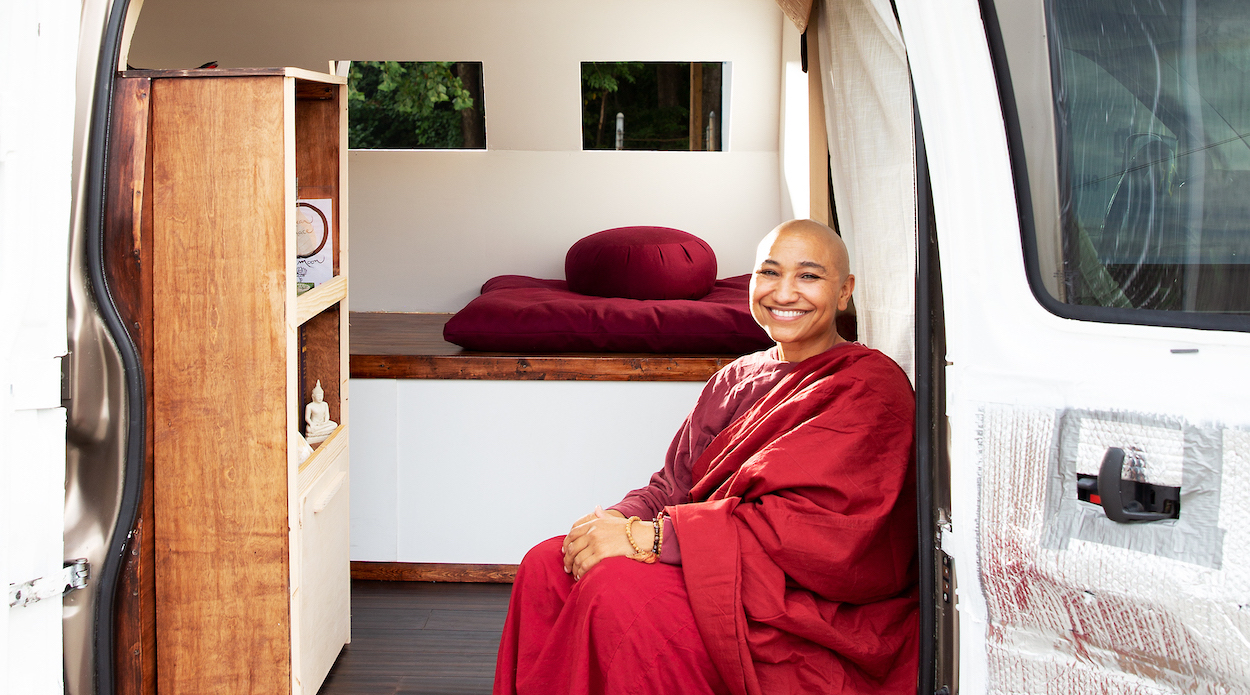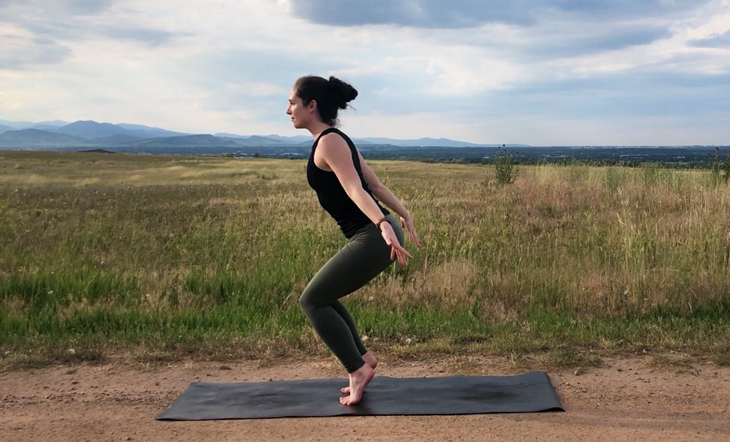Inside the Traveling Nunk’s Mobile Monastery
Sister Clear Grace Dayananda is driving across the US in a 2003 Chevy van: “I did a lot of research, watched a lot of videos on YouTube, and made a lot of mistakes,” she says. The post Inside the...

Trike Daily ReflectionsPersonal Reflections
Sister Clear Grace Dayananda is driving across the US in a 2003 Chevy van: “I did a lot of research, watched a lot of videos on YouTube, and made a lot of mistakes,” she says.
By TricycleMar 20, 2022 Photo by Stacey Van Berkel
Photo by Stacey Van BerkelOn September 15, Buddhist monastic Sister Clear Grace Dayananda set out across the United States in the Great Aspiration, a Chevy van she converted into a portable meditation hall. This mobile monastery is the centerpiece of a project she calls the Traveling Nunk, which aims to make dharma teachings accessible to marginalized communities. Through chanting in public parks, collaborating with local faith groups, and giving out meals to those in need, she aspires to use her practice to move toward suffering and act with compassion and equanimity.
In a recent episode of Life As It Is, Tricycle editor-in-chief James Shaheen and Sharon Salzberg sat down with Sister Clear Grace to talk about her travels through the American South, the practice of meeting people where they are, and how we can learn to love those with whom we disagree. Read some excerpts from their conversation below, and listen to the full episode, “On the Road to Awakening with the Traveling Nunk.”
On moving toward suffering
This project, the Great Aspiration, has the power to take our dharma practice off of the cushion. How do we meet people where they are, and what have we been practicing for? What has the dharma taught us, and how do we engage with that? The Buddha’s teachings are full just as they are, and we don’t have to change them to fit our life or the suffering that we’re seeing. They can give us the energy and power to go into the suffering, so when we are faced with it, we’re ready for it. We’ve been training for these times. We’ve practiced well. A lot of us come to the dharma for self-reflection or inward practices of emptiness and the brahma-viharas. But at some point, these meditation practices should catapult us into the suffering in the world around us because we now have a higher capacity to hold all things without being carried away by our views. We are dharma responders, and we have to move toward suffering while bringing the presence and wholeness our practice gives us.
On building the Great Aspiration
The pilgrimage launched on September 15, 2021. I worked on converting and rebuilding the Great Aspiration (a 2003 Chevy van) for about three months with the help of a friend, who is a carpenter. I did a lot of research, watched a lot of videos on YouTube, and made a lot of mistakes—there were often sparks flying. Even though it’s a small space, I still had to build a home. We worked hard on it from early morning until the end of the evening, and it was really an act of compassion. There was this energy that came from the dharma. I was beyond my mental capacity, beyond my knowledge, and there were times where things would come together even when I felt like I didn’t know what I was doing. I had to look back and realize this was not me—this was just the power of the dharma. This is the fruit of practice.
On equanimity as loving beyond disagreement
For me, the practice of equanimity involves mindful alertness and being able to see the dharma, as well as our own desires and tendencies. We have to know where we are, and we have to be honest with ourselves. We have to know what we can enter into. We have to know our capacity. But we have to also be willing to do the work, to be able to come to the fullness of our practice so that we can see its fruits and so that we can transcend our own biases and discriminations. With the power of the dharma, we can hold our views while also honoring the love and connection with those we disagree with. Being able to cultivate that moment of connection has been one of the biggest lessons on this journey.
When clinging attachments arise inside of me, I know that I’m picking up a view, and the love can no longer be as it needs to be. But when I can see all of its parts, when I can know that it’s there and come to the fullness of understanding it, then there’s compassion on all sides, and there are no more sides. Then I’m able to come to that place in my wholeness, in my seeing all of the dharma, and meet that individual where they are. In that connection, we can begin to love our way through disagreement. This is an active leaning in, a destructing or a dismantling, so that we can be there and be present. Sometimes this is just my own internal work: How can I remove the defilements within me so that I can come to the fullness and love and expand my heart in the presence of views or disagreements without feeding the separation?
On the brahma-viharas in action
We’ve been through a lot as a nation, and I think we’re all looking for that outbreath in each other. I partner with a lot of churches doing service work, and I’m meeting a lot of the spirit of Christ here on the streets, definitely in the South. It’s empowering. It’s inspiring. I met this one bodhisattva in Knoxville, Marty, who opened up an empty parking lot with a chain link fence and offers showers and food and places for people to charge their phone every Sunday. She welcomed everybody. She knew everybody’s name and helped people come back into their bodies in crises, whether due to mental health or substance use. In her work, she is just present in all of her fullness. One woman was repeating, “I need a cigarette. I need a cigarette.” In the spirit of Christ, Marty was just being there, not offering the cigarette but also not saying, “No, it’s not good for you” or sharing her own views. Instead, she said, “Let’s eat a banana. You really need to eat something,” and gave her a banana. Then she got her some water and stayed there with her, encouraging her. To me, this was an example of the brahma-viharas in action for those who are suffering or for those who are in need in front of us. It takes great work as a practitioner to be able to be there fully and to be present without our views and our judgments. In that moment, community is community. It’s just human beings taking care of each other in all ways.
♦
Listen to the full podcast episode here:

Get Daily Dharma in your email
Start your day with a fresh perspective

Explore timeless teachings through modern methods.
With Stephen Batchelor, Sharon Salzberg, Andrew Olendzki, and more
![]()
Thank you for subscribing to Tricycle! As a nonprofit, we depend on readers like you to keep Buddhist teachings and practices widely available.
This article is only for Subscribers!
Subscribe now to read this article and get immediate access to everything else.
Already a subscriber? Log in.

 Tfoso
Tfoso 































